Bonsai Tools: Essential Equipment for Beginners
Bonsai, the art of cultivating miniature trees, has long captivated hobbyists around the world. There’s something truly rewarding about nurturing a bonsai tree and feeling connected to nature even in the smallest of urban flats. Shaping and caring for these delicate indoor gardens offers us a chance to unwind and unleash our creative potential.

Understanding the tools of the trade is essential for anyone keen to embark on the bonsai journey. We aim to guide you through the selection and use of various bonsai tools, ensuring your diminutive trees remain healthy and happy. From stainless steel bonsai tools that help refine your tree’s silhouette, to specialised soil mixes and fertilisers that provide the nutrients your bonsai craves, knowledge of these essentials is a gateway to bonsai mastery.
We’ll also explore how training wires can sculpt and direct growth, and discuss the often overlooked elements like appropriate tents for outdoor bonsai or specific lighting requirements for indoor varieties. Lastly, we will touch on modern irrigation techniques for optimal watering and other handy tools to keep your bonsai in top condition. This article is packed with clear, concise information to help you make the most of your bonsai experience.
Key Takeaways
- Bonsai cultivation is a relaxing hobby that enhances creativity and connection to nature.
- Essential tools and their usage are crucial for maintaining a healthy bonsai.
- The article provides a comprehensive guide on tool selection, tree care techniques, and bonsai upkeep.
Pruning Tools

We all agree that shaping our bonsai is a delicate process which maintains its appearance, controls growth and enhances its overall health. When we discuss pruning tools, we’re not just talking about any old scissors; we’re referring to quality bonsai tools designed to ensure clean cuts that heal well, maintaining the aesthetic and well-being of our tiny trees.
If you are looking to pick up quality bonsai pruning tools today Miyagi Bonsai have you covered. We have an extensive range of pruning tools from essential to specialist available from our online store. If you’re in the market for some but would like a bit of guidance on pruning tools are beginner guide is available to help you get started.
Scissors & Shears
Bonsai scissors come in various shapes: from large and robust to finely pointed, reflecting their diverse uses. Our typical pair of scissors needs to be sharp, durable, and provide a clean cut. They are perfect for the art of bonsai, carving our tree’s appearance precisely as we envision.
- General Purpose Scissors: Used for a variety of tasks like cutting roots and trimming buds.
- Specialised Scissor Types: Include those designed for more intricate work, such as bonsai pruning scissors or leaf cutters for dense foliage.
Wire Cutters
Wire cutters are an essential tool not for the tree itself, but for the wires we use to shape them. They come in various sizes but what they share in common is the need to be capable of snipping the wire without damaging the branches. It’s crucial to look for quality, especially in the finish and sharpness.
- Standard Wire Cutters: Made typically of stainless steel and used for general wire cutting.
- Heavy-Duty Wire Cutters: These have extra leverage for thicker wires that standard cutters can’t handle.
Root Rakes
A bonsai rake might seem out of place in a pruning tools discussion, but it’s indispensable. Rakes help us to clear away surplus soil and detritus, allowing us to prune roots effectively during repotting. This process is crucial for the health of the bonsai, enabling better nutrient intake.
- Two-Prong Rakes: Ideal for gentle detangling of roots without causing undue damage.
- Three-Prong Rakes: These have a spatula on one end and are better suited for more demanding soil work.
When we maintain our tools, durability increases, and the health of our bonsai is preserved. We recommend regularly cleaning our tools to prevent disease spread and keeping them sharp so each cut is clean and precise. Remember, the choice of tool often correlates with our bonsai’s size and the type of work required, so choose wisely for a happy, healthy tree.
Feed & Soil
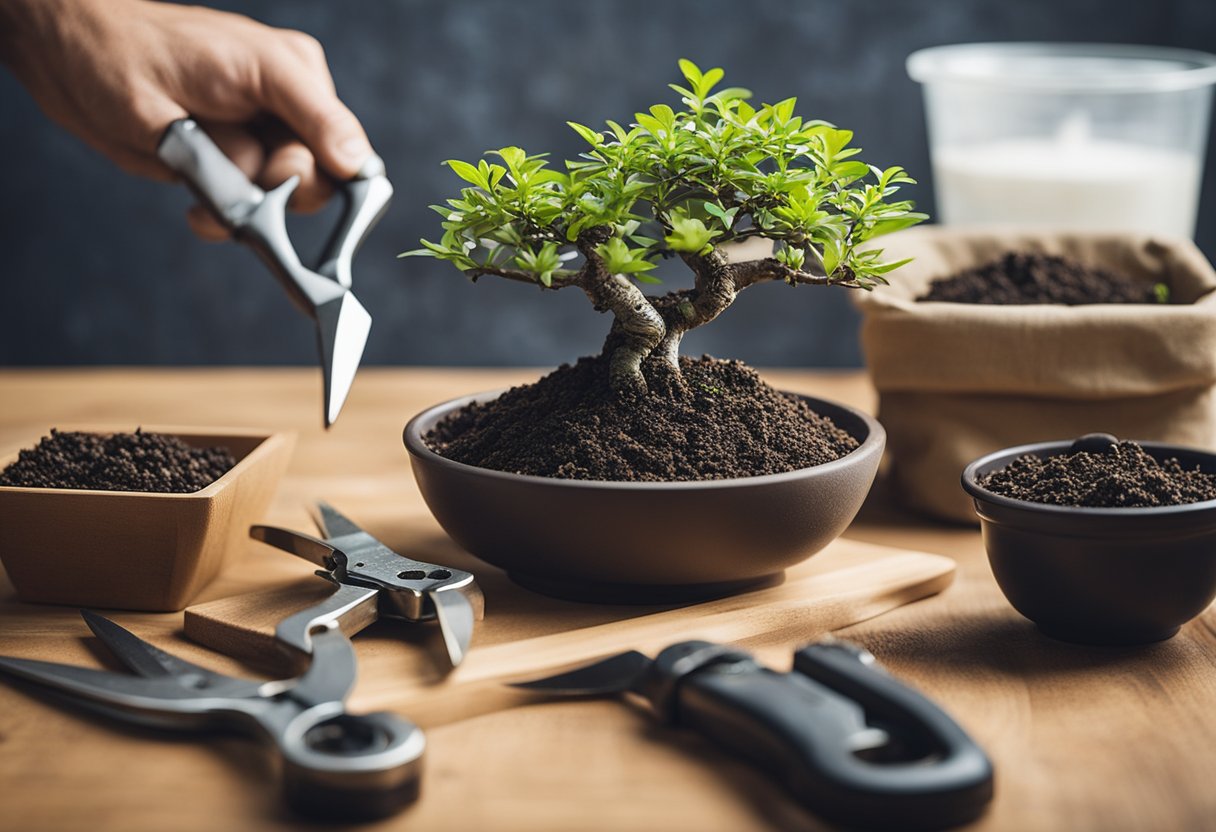
In our journey of bonsai cultivation, we’ve discovered that two crucial elements truly make a world of difference in our miniature trees’ health and growth: the quality of feed and the type of soil we use.
We at Miyagi Bonsai appreciate the soil and fertilizer used in our green-thumbed adventures are fundamental to their success. We stock an expansive range of feed and soil for your bonsai in our online store, available today. It can be a little daunting to know where to start. So if you’re looking for some pointers on feed and soil, our beginner’s guide is available to set you on the right path.
Bonsai Soil & Bonsai Fertiliser
Why is soil pivotal for our bonsai, you ask? Well, it’s the foundation for any bonsai tree, providing essential nutrients, proper water retention and drainage, and support for the roots. Let’s chat about the different kinds of bonsai soil available and what makes each special.
Organic Bonsai Soil: This soil is composed of natural materials that break down over time, like peat, bark, and leaf litter. Organics can hold a good amount of water and nutrients, which is fantastic for our thirsty little trees.
Pros: Excellent water retention, enriches the soil with nutrients as it decomposes.
Cons: Can compact and reduce drainage over time, occasionally requiring more frequent repotting to maintain soil structure.
Inorganic Bonsai Soil: These are non-organic materials like akadama, pumice, and lava rock. They’re brilliant at providing aeration and drainage.
Pros: They promote strong root growth and rarely break down, meaning less frequent repotting.
Cons: They can be less able to hold onto nutrients and water, requiring more attentive feedings and watering on our part.
Mixed Bonsai Soil: A bit of this, a dash of that; mixed soils combine organic and inorganic elements. It could include a mix of akadama, lava rock, and pumice, with a sprinkle of organic materials to balance moisture retention and aeration.
Pros: Tailor the mix to your tree’s specific needs, which can be a real game-changer.
Cons: It can be trickier to get the balance just right—too much of one component can throw the mixture off.
When we consider our bonsai soil, quality is at the forefront. Products used by professionals make all the difference. Low-quality, incorrect, or poorly prepared soil can lead to poor drainage, root rot, or undernourished trees.
The fun doesn’t stop at picking soil. Once we’ve selected the best mix for our bonsai, it’s about getting the feeding right. Our little trees need more than just water – they need a balanced diet. There are various feeds available:
Liquid Feeds: Convenient and easy to mix with water but require regular application.
Granular Feeds: Slow-release and great for a steady nutrient supply but need to be carefully applied to avoid over-fertilisation.
Organic Options: Fish emulsion, compost teas—smelly at times, but full of microbial activity that benefits soil health and, in turn, our bonsai.
There are inorganic options too, which are often more concentrated and require careful measurement to avoid harming our cherished trees.
Here are some quick tips:
Choosing Soil: Think about your bonsai species – does it love moisture or require excellent drainage? Select a soil type that matches.
Applying Feed: Be seasonal! Our bonsai have different needs throughout the year; they’re like us, needing different outfits for each season.
Storing Soil and Feed: Keep them dry and out of direct sunlight to maintain their quality. Think of them like a fine wine, worth storing properly.
Remember, whether a seasoned bonsai artist or a budding enthusiast, getting hands-on with feed and soil will make us the architects of our bonsai environment. It’s utterly satisfying to see our miniature trees thrive with tools to suit our careful choices and tender care.
Training Wire
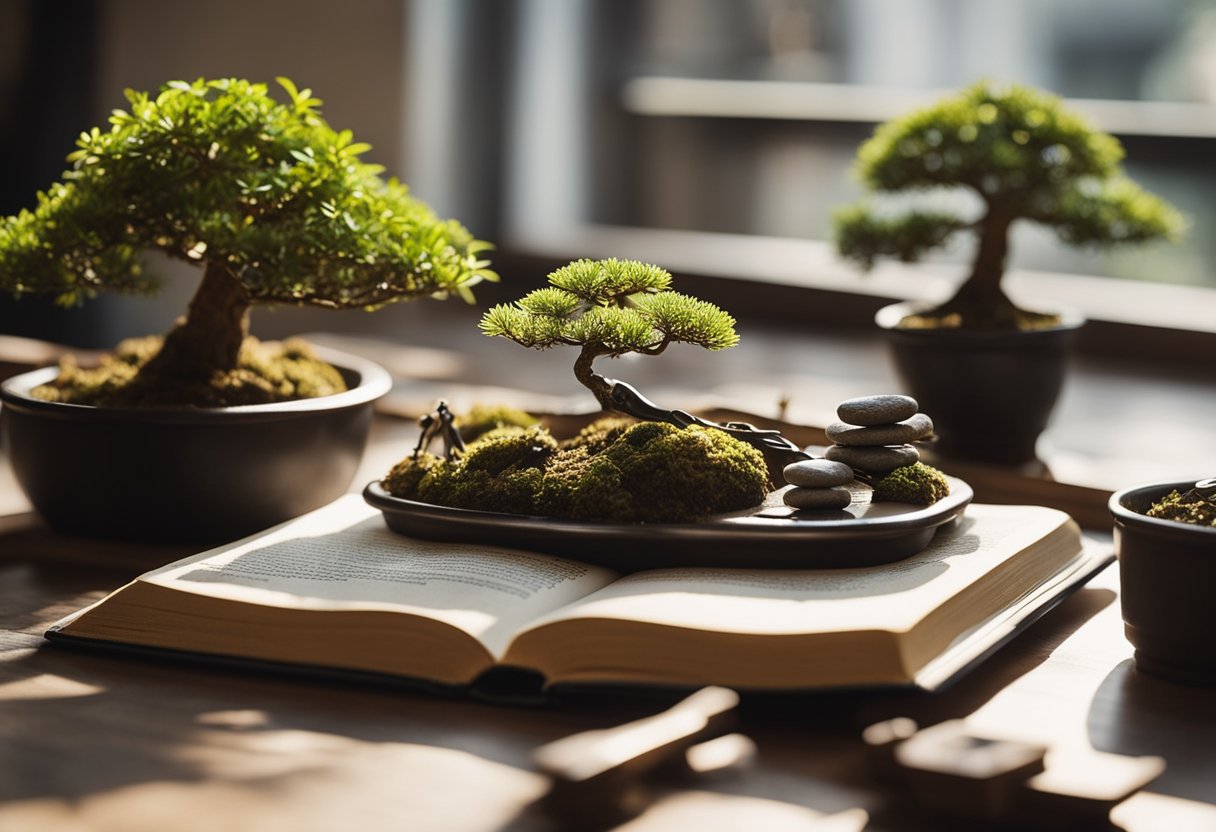
When we talk about bonsai, training wire is an indispensable tool for us. It helps us to bend and shape branches and trunks, guiding the bonsai to grow in the desired form. Now, let’s take a closer look at the types of training wire we might use.
When talking about wire, training wire and shaping the Bonsai, we appreciate to a beginner this can all sound a bit technical and daunting. Fear not, here at Miyagi Bonsai we stock a considerable selection of training wire for your bonsai maintenance. We also understand that you may be hoping for a little more than the product itself. If you’d like some pointers on wiring we have a helpful guide available for your perusal.
Bonsai Wire
There are mainly three types of training wires we often come across: copper, aluminium, and stainless steel. Each has its own set of characteristics that make it suitable for different scenarios.
Copper wire is traditional and one of the most reliable materials for bonsai training. It’s sturdy and holds its shape well, which is excellent for manipulating thicker branches. However, copper wire can be a bit more challenging to work with due to its rigidity and is more likely to cause damage to the tree if not used carefully.
Aluminium wire is softer and more malleable than copper, making it a popular choice among beginners. Its flexibility allows for easy application and adjustments. Aluminium also tends to be lighter, which reduces the risk of damaging the branches. A potential downside is that because it’s softer, it may not hold heavy or thick branches as well as copper.
Stainless steel wire is less commonly used but offers a middle ground between copper and aluminium. It’s stronger than aluminium but more flexible than copper, which can be advantageous for certain bonsai shaping techniques.
Here’s what we should keep in mind when choosing our wire:
- Quality: Opt for high-quality wire to avoid damaging the tree. Poor-quality wire can rust or break easily.
- Size: Use the appropriate thickness. A general rule is to use wire that’s about one-third the thickness of the branch being wired.
- Application: Apply the wire at an angle of 45 degrees to the branch, wrapping carefully to avoid scarring.
When removing the wire, we must do so before it starts digging into the growing bark. Cutting the wire off rather than unwinding it is often safer for the health of the bonsai.
So, as we select our training wire, let’s ensure we’re making informed choices. With the right wire in hand, we’re on our way to creating beautiful bonsai forms! Remember, patience is key—both the trees and our skills will grow over time.
Tents

When we’re tending to our bonsai trees, have you ever worried about how they might fare against the unpredictable British weather or pesky intruders? That’s where tents come into play – they’re our little green friends’ best line of defence.
So, you came in search of just a few tools and now you’re looking at getting your bonsai a roof over its own head! Here at Miyagi Bonsai we have an ample selection of tents for your Bonsai online and at our store in London. If you’re looking for some guidance on the best tents to purchase we also have a handy beginner’s guide for you to take a look at.
Types of Tents:
Plastic Tents:
Benefits: Provides a waterproof shield and retains warmth.
Drawbacks: Can limit air circulation.
Uses: Perfect for young bonsai or during heavy downpours.Fabric Tents:
Benefits: Breathable and often UV-resistant.
Drawbacks: Less durable against extreme conditions.
Uses: Ideal for maintaining consistent humidity.Mesh Tents:
Benefits: Excellent ventilation and protection from insects.
Drawbacks: Offers less thermal protection.
Uses: Great for summer use, keeping pests at bay while allowing fresh air.
Choosing a Tent:
- Look for durability and functionality.
- Consider the size of your bonsai and the space you have available.
- Select a tent material that suits your local climate and the specific needs of your bonsai.
Setting Up and Maintenance:
- Location is key: Find a spot that receives the right amount of sunlight.
- Easy does it: Assemble with care to avoid tearing or damaging the tent.
- Regular checks: Keep an eye out for condensation, mould, or pests.
- Clean it up: A tidy tent is a happy tent, so clean it occasionally with a gentle disinfectant.
Mesh types might resemble a net thrown over a framework, while fabric tents could appear as a small greenhouse. Each tent comes in various shapes and sizes, fitting snugly around our tender bonsai trees. Remember, mates, a well-chosen tent can mean the difference between a bonsai that survives and one that thrives. Keep these tips in mind, and our bonsai trees will be thanking us!
Lighting
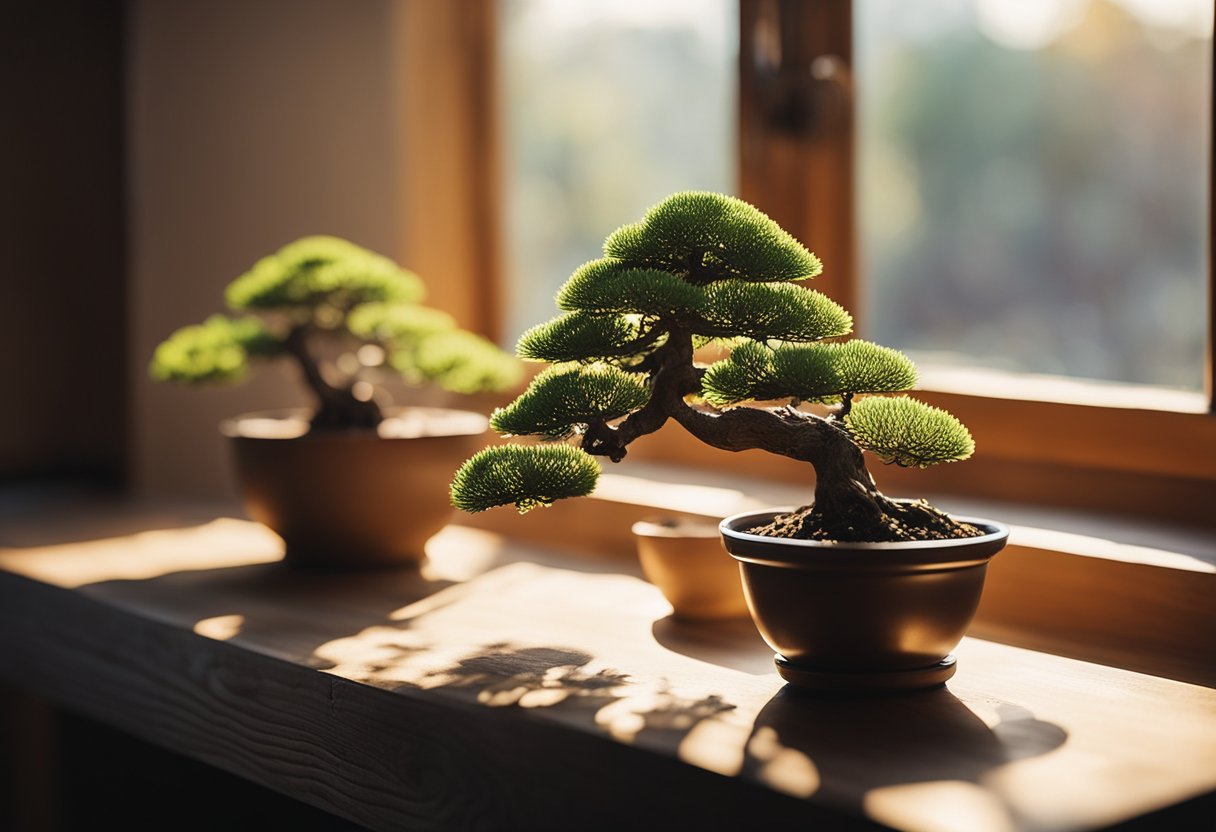
Have you ever wondered how vital light is for our indoor bonsai trees? Well, just like us, these miniature wonders crave the optimal balance of light to strut their leafy style. The right intensity and quality of light are crucial for the bonsai’s photosynthesis, health, and growth.
Getting the right light for your plant is a non-negotiable must for anyone from an aspiring green thumb to a long-time gardening maestro. We have a comprehensive selection of lighting tools for your choosing in our online store. If this is all a bit overwhelming and you’d like some guidance on the best lighting for your bonsai we have a practical beginner’s guide for you to look at too.
Types of Lighting:
- Natural Light: It’s the gold standard. But getting natural light right, especially for indoor bonsai trees, can be a bit like solving a Rubik’s cube—tricky!
- Artificial Light: Ideal for those dreary corners where sunshine is a rare guest. LED lights are a popular pick due to their efficiency and ability to mimic the natural light spectrum.
- Supplemental Light: For when the British weather pulls a grey curtain over the sun; this is our wingman, stepping in to provide those needed rays.
Choosing Your Light:
Think of these as the ABCs of bonsai lighting:
- A for Amount: How much light do our green pals need? Typically, it’s about 10-14 hours a day.
- B for Brightness: Too dim, and the bonsai’s growth can turn spindly; too bright, and our leafy friends might get a sunburn!
- C for Colour spectrum: Aim for a balance, with enough blue for leafy growth and red for flowering and fruiting. It’s all about that blend.
So, how do we ace this light game? Here’s a quick how-to:
- Assess your space: Where does your bonsai live? What’s the natural light like?
- Get tech-savvy: Literally! Use tools like a dimmer on your fixtures to control the intensity.
- Install with finesse: Direction matters. Angle lights for even distribution, and prevent the dreaded one-sided tan on your bonsai.
In summary, play with light like a maestro, harmonising natural and artificial beams to compose a masterpiece of verdant health for your bonsai!
Irrigation
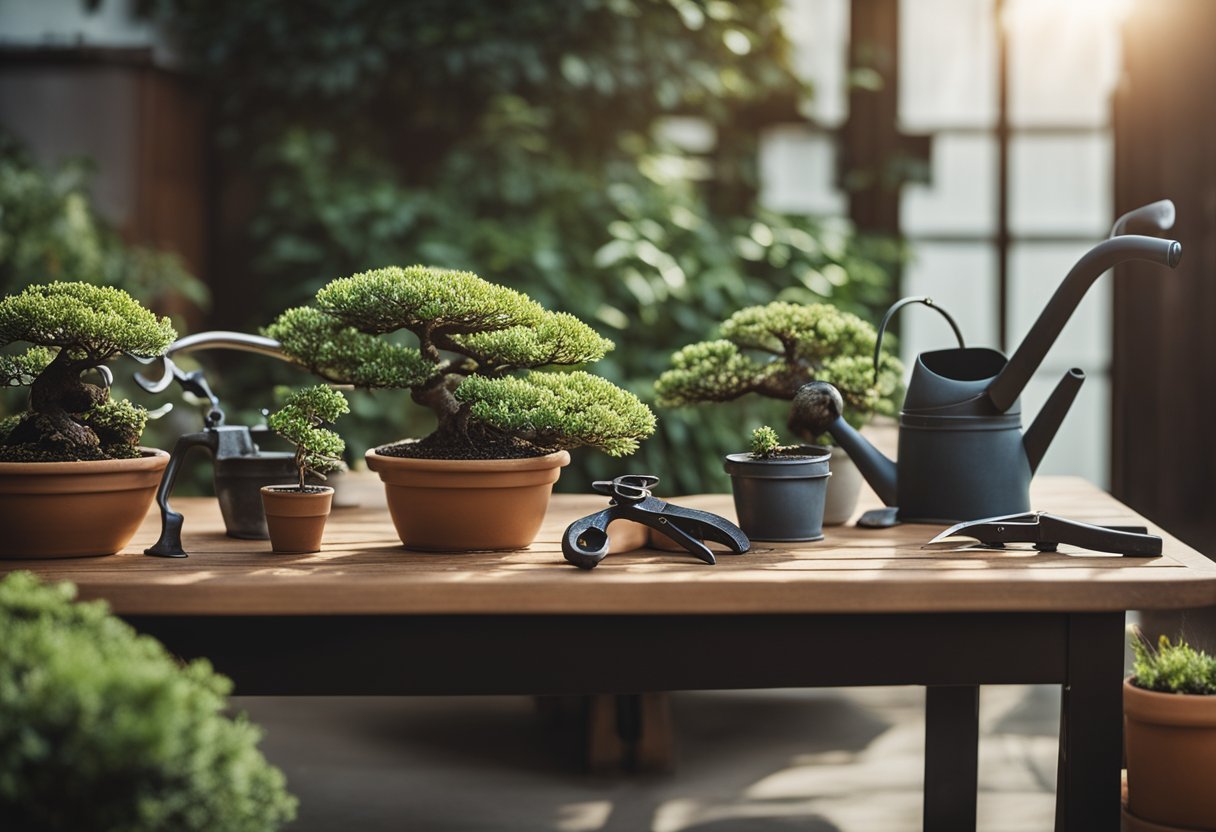
When we talk about the health and longevity of our beloved bonsai trees, maintaining the perfect balance of moisture in the soil is vital. It’s all about hitting that sweet spot—not too soggy and certainly not too dry. A well-irrigated bonsai is a happy one, with soil that’s damp as a British morning dew, just right for the roots to absorb both water and nutrients without gasping for air.
Irrigation is an all-important matter in Bonsai care. Across over 100 species Bonsai range from drought-tolerant to in need of regular sprinkling so getting your irrigation right is key. We stock a sizable range of irrigation tools for your Bonsai journey. If you’d like a little bit of guidance on the best irrigation tools to purchase, our handy guide can put you on the right track.
Now, watering methods can be as varied as the bonsai shapes we treasure. Let’s have a gander at the options:
- Watering Cans: Those traditional, quaint watering cans are not just for show; they allow us to water our bonsai with precision and a gentle touch.
- Hoses: Need to give a good soak quickly? Hoses can come in handy, but remember, it’s more of a brute-force approach.
- Sprinklers: Automated and even coverage? Sprinklers can be the efficient choice, although over-watering can become a party crasher.
- Drip Systems: Fancy a more tech-savvy method? Drip systems customise water delivery to each bonsai’s thirst level, but require a little setup savvy.
| Method | Advantages | Disadvantages | Best for |
|---|---|---|---|
| Watering Can | Precision, control | Time-consuming | Daily up-close care |
| Hose | Fast, easy | Easy to over-water | Quick soak for multiple trees |
| Sprinkler | Automated, consistent | Risk of over-watering | Scheduled watering |
| Drip System | Customised, water-saving | Initial setup required | Precision watering, larger collections |
So, how do we decide on the best irrigation method? Consider these points:
- Size of your bonsai collection
- Time you can commit to watering
- Layout of your bonsai display
To monitor your bonsai’s soil moisture, get your hands on a moisture meter or simply use the good old finger test—poke the soil and see if it clings to a dry finger!
Remember, chums, no one method suits all. Keep experimenting until you find your bonsai’s best mate for hydration. Keep the watering consistent, be observant, and these age-old miniature marvels will thank you with their lush foliage and awe-striking presence.
Other Tools
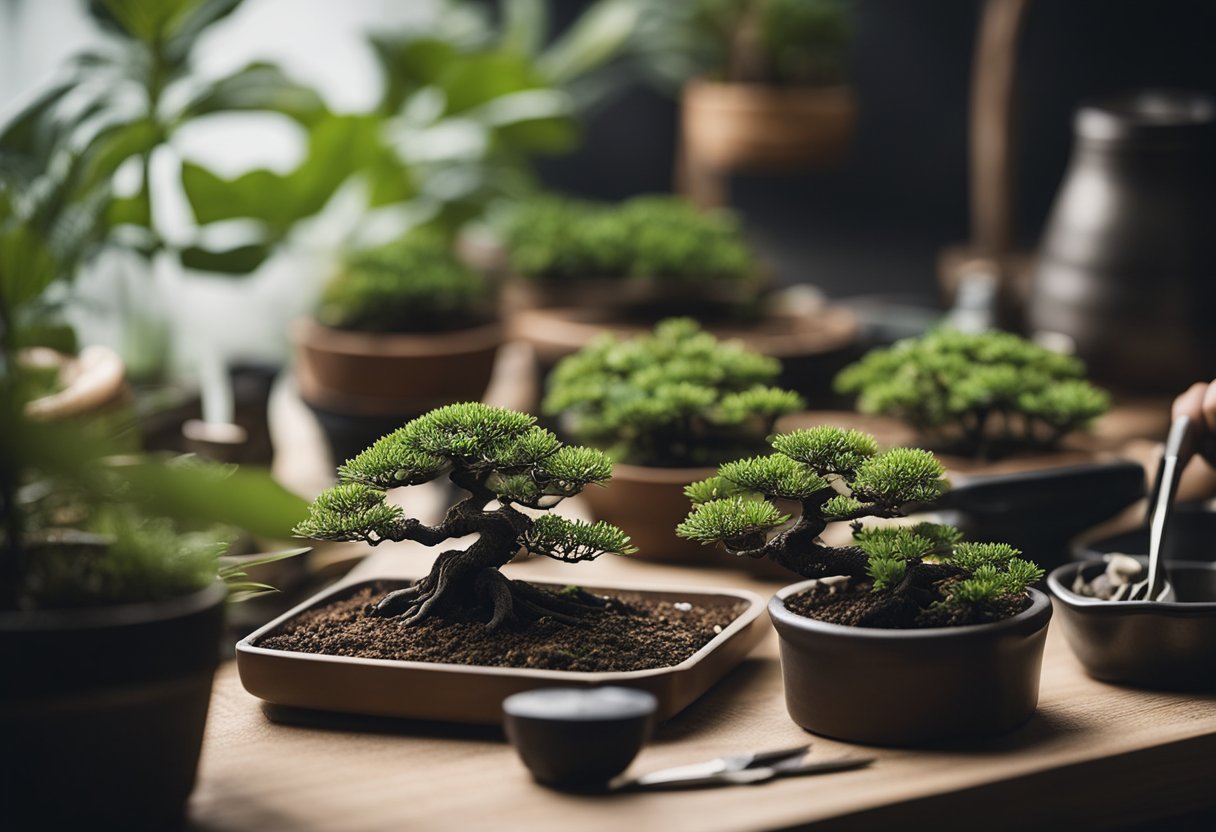
Have you ever wondered how every bonsai tree manages to look so perfect? It’s not just top quality bonsai tools that do the trick; it’s also the smaller gadgets that enhance the overall aesthetic and functionality. Let’s talk about a few essentials that may not be the first to spring to mind when considering bonsai tool kits, but they’re certainly important.
First up, chopsticks. Not just for sushi, folks! In the world of bonsai, they’re incredibly versatile – think probing for moisture levels, teasing roots or aerating soil. Affordable and easy to find, chopsticks are a must-have.
Then, there’s the turntable. It’s like a Lazy Susan for your bonsai, making it much easier to work on every angle without having to contort yourself. Who doesn’t love a bit of convenience?
There are top-quality bonsai tools that often go unnoticed, take the root hook. A root hook is a specialist tool that provides much finer work than your average root rake. These tools are made to loosen and untangle the roots of a tree during repotting or root pruning. With its sharp, curved metal tip, it is a useful tool to work through the root system, promoting healthy root development.
Among the best bonsai tools commonly used by many is the saw. Used to cut branches and trunks of the thicker, heavy duty variety, a micro saw for your Bonsai tends to come in foldable form and will only come in handy as you progress on your Bonsai journey.
It’s also worth considering the bonsai brush among our range of tools. When learning the bonsai basics it’s recommended for beginners to have an appropriate brush to wipe away the dirt and dust on the tree and its soil to ensure it is in optimal condition.
Let’s not forget the humble bonsai pot. A bonsai’s home says a lot about the overall presentation. And trays and stands? They do the double duty of providing drainage and displaying your tree in all its glory.
- Purpose & Use: Provides an array of functions from displaying to maintaining your bonsai.
- Features: Varied sizes, materials and designs fitting different bonsai styles and sizes.
Choosing tools can be a bit of a balancing act between quality and budget. Aim for the best your wallet can handle – it’s worth it in the long run. We supply an expansive range of other tools that can aid you on your bonsai journey. If you’re not sure where to start and would like some pointers on other tools, the best to buy at different price ranges, check out our nifty beginner’s guide.
As for storage, keep them clean, dry and tucked away. Well-maintained tools are essential to keep those bonsais looking pristine.
Now, are we ready to get our bonsai collection looking spick and span with these nifty little tools? Absolutely!
Conclusion
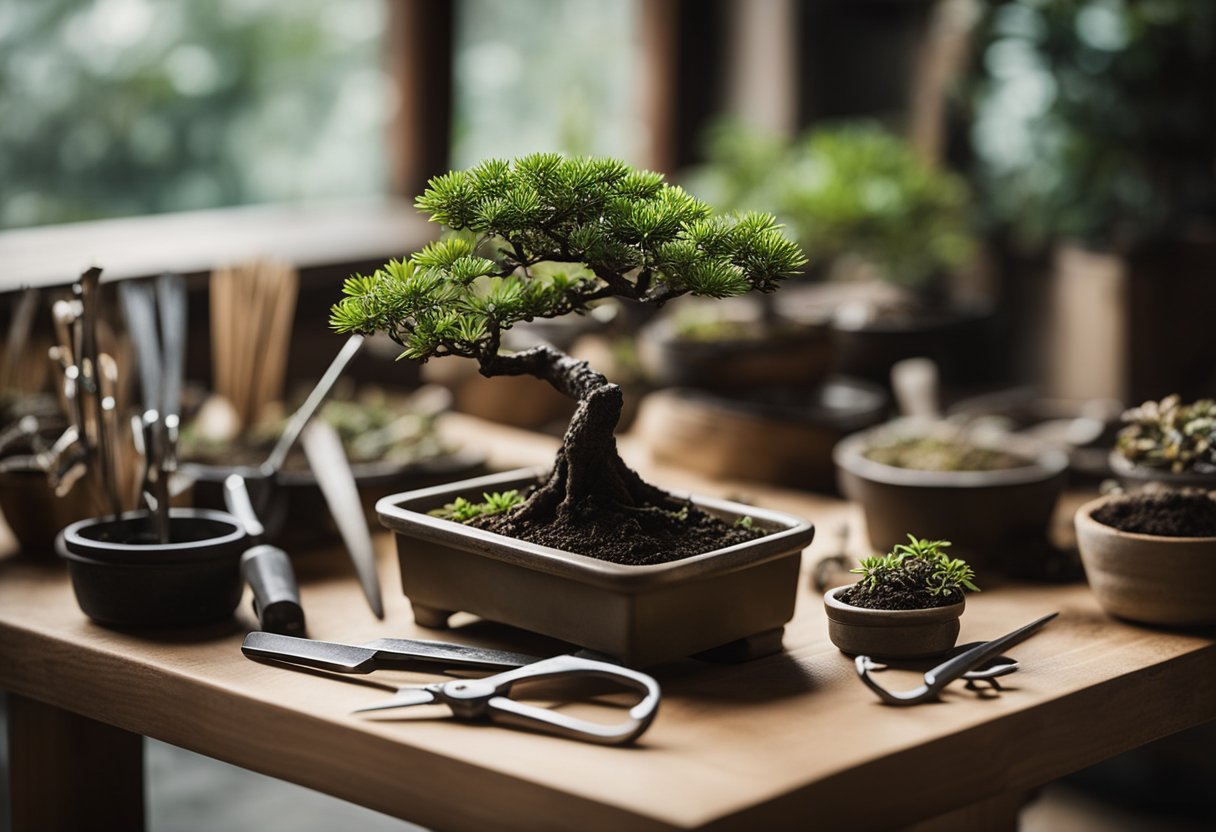
In our exploration of bonsai tools, we’ve learnt that the right equipment is key to the success and joy of cultivating these miniature trees. Bonsai care requires specific tools that can be remarkably similar to standard garden equipment but with slight modifications for precision work. A simple pair of bamboo chopsticks or knob cutters, often overlooked, prove invaluable for tasks like aerating the soil and repotting.
Each tool in a bonsai artist’s arsenal serves a purpose, from shaping branches to securing roots. Their correct use not only ensures your bonsai remains healthy but also enhances your overall experience as you shape nature’s artwork.
Remember, it’s not just about owning the tools—it’s about the connection you create with your bonsai. We’re in this together, sharing the pursuit of a green-fingered hobby that brings immense fulfilment. So, let’s keep those tools rust-free and our bonsai thriving, shall we?
FAQs
Embarking on the bonsai journey unveils a multitude of queries. We intend to address the quintessential ones, ensuring you’re well-equipped to nurture your miniature marvels with finesse.
To commence your bonsai practice, we recommend securing a set of basic, yet indispensable tools. A pair of sharp bonsai shears is paramount for precision cutting, accompanied by wire cutters for shaping, and a root hook for repotting duties. These foundational tools pave the way for adept bonsai care.
Quality profoundly influences the lifespan and efficacy of bonsai tools. High-grade steel instruments offer enhanced sharpness and durability, enabling precise cuts which foster quicker healing for your bonsai. Conversely, inferior materials may lead to subpar results and frequent replacements.
Certainly, we can! Look for a beginner’s bonsai toolset that encompasses the critical pieces: shears, wire cutters, and a root hook. Many suppliers provide budget-friendly kits without compromising on quality—the key is to investigate and compare to find an ideal compromise between cost and calibre.
We at Miyagi Bonsai stock a comprehensive range of authentic Japanese tools. It’s worth visiting our online shop to see the Japanese bonsai tools for sale before making your choice.
Look no further than here at Miyagi Bonsai. We have an online store stocked with all the essential bonsai tools you could need and clear guidance on how to use them. You’re also more than welcome to visit our store to make your selection of quality tools in person.
Caring for your tools is integral. We advise regularly cleaning your implements post-use, lubricating the moving parts, and keeping them dry to stave off rust. Sharpening the blades as necessary will ensure your tools remain in prime condition for years to come.
